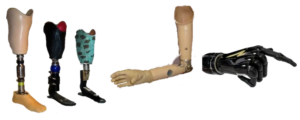
Prosthetics and orthotics are medical devices that help replace or support any part of the human body. They allow people with disabilities to regain mobility and live fulfilling lives. Recent advancements in materials science and engineering have revolutionized these fields, creating more comfortable and lifelike prosthetics and orthotics. This article explores some of the latest innovations and how they are transforming lives.
Materials Science Advances
Modern prosthetics and orthotics rely on advanced materials to achieve natural movement and comfort. Lightweight materials like carbon fiber allow for more mobility than older metal designs. New thermoplastics can be easily molded to a patient’s unique shape and softened for adjustment. 3D printing now makes it possible to quickly produce custom parts. Researchers are also working with smart materials like shape memory alloys that can change shape in response to temperature or electricity. These “active” materials open up possibilities for prosthetics that automatically adjust their grip or stiffness level based on the wearer’s activity.
Myoelectric Prosthetics
One exciting area is the development of myoelectric prosthetic arms and hands. These devices use electromyography (EMG) sensors to detect electric signals from remaining muscles when the wearer imagines moving their missing limb. Onboard processors translate these signals into motion of the prosthetic. State-of-the-art myoelectric hands can now open and close their fingers, rotate their palm, and even perform delicate tasks like tying shoelaces. Some models have improved tactile feedback too, letting amputees “feel” objects they are holding. As sensors and computing power continue advancing, it may eventually be possible for amputees to control prosthetics nearly as naturally as their original limbs.
Bionic Legs Give New Freedom
Some impressive bionic leg technologies now restore independent walking. Microprocessor-controlled knees sense the terrain and modify their stride accordingly. Shock absorbers mimic real muscles to provide stability on uneven ground. Ankles with multiple joints allow for climbing stairs or slopes easily. Fitted correctly, these advanced leg prostheses can enable amputees to hike, cycle, play sports or complete physically demanding jobs that weren’t possible before. This newfound mobility has life-changing mental health benefits as well. Patients say regaining the ability to walk freely vastly improves their sense of normalcy and confidence.
Custom Orthoses Deliver Daily Support
While prosthetics replace missing body parts, custom orthotics are designed to support injured or weakened areas of the body. For example, 3D scans and pressure mapping technology allow precise fabrication of foot orthotics customized to correct biomechanical faults and reduce pain from conditions like plantar fasciitis. New thermoformable plastics mean orthotic shells can be smoothly molded to comfortably cradle feet or other areas in need. Some orthopedic braces now contain flexible plastic slings that automatically lend support when pressure is applied, taking the strain off injured muscles. With devices tailor-fit to individual needs, custom orthotics effectively manage pain from arthritis, back injuries and other chronic issues, improving mobility and quality of life.
Smart Fabric Integration
Looking ahead, researchers envision weaving electronic components directly into the fabric of prosthetics and orthotics. Flexible circuits, batteries and sensors could one day be seamlessly incorporated during the garment-making process. This would eliminate bulky external components while enabling totally new functionalities. Invisible “smart fabric” sockets may automatically adjust pressure points for comfort. Integrated EMG or motion sensors could make prosthetic control more intuitive than ever before. Orthotics might include subtle vibration alerts if wearers overstress injured areas. As fabrication techniques mature, assistive garments with intrinsic high-tech abilities could truly achieve transparency and normalcy for their users.
Conclusion
Advancements in materials science, biomechanics, computing and personal fabrication are radically progressing the fields of prosthetics and orthotics. Where functionality was once rigid and limited, today’s devices restore natural, independent mobility through lightweight, responsive and customizable designs. The future promises assistive technologies that become even more seamless extensions of the human body. With continued interdisciplinary research, prosthetics and orthotics will continue empowering those with disabilities to live full, active lives.
*Note:
1. Source: Coherent Market Insights, Public sources, Desk research
2. We have leveraged AI tools to mine information and compile it


